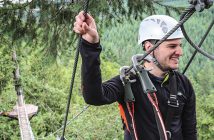STATIC BELAYS
While there are several suppliers of static belay gear, Petzl is one of the best-known. The company refers to its line of JOKO lanyards, which it sells to aerial parks, as progression lanyards. “This is a simple, lightweight design,” says Jeremiah Wangsgard, technical information manager for Petzl. “It’s your more traditional system, where the client is clipping and unclipping as they pass intermediate anchor points of whatever obstacle they are traveling. It reduces the number of connectors, like carabiners, because it attaches directly to the harness.”

Left: Petzl’s JOKO lanyards employ the traditional system design, in which the clients clip and unclip carabiners, one at a time, as they navigate obstacles. Right: In Kong’s CouDou Pro continuous belay system, the PAIG plate allows a course to split. Once on the line, the system’s ZAZA2 CS connector will only slide off the lifeline at one end or the other.
The lanyards come in a single leg version (the JOKO-I) and a two-leg version (the JOKO-Y). The JOKO lanyards are dynamic rope lanyards designed to be girth-hitched to the guest’s harness, and the lanyard is designed to help absorb some energy in case of a fall. Still, like any adventure park lanyard, they are not designed to take a lengthy fall. The JOKO-I comes in three lengths (30, 45 and 70 cm), while the JOKO-Y is available in two lengths (60 and 85 cm). Both are sold in packs of 10.
SMART BELAYS
In addition to heading up distribution for the Edelrid Adventure line through Adventure Park Gear, Komenda is the president, CEO and founder of Tree-mendous, which builds and develops adventure parks. “As builders we were looking for advanced equipment to use in our parks back when we were using carabiners,” Komenda says. “The Edelrid smart belay was invented in Germany by a builder who had the same problem as us—we had great parks, but how do we make sure people don’t accidentally unclip? They were one of the biggest builders, if not the biggest builder, in Germany, and came up with the first version of the smart belay—the principle of two carabiners communicating with each other through a cable.”
Edelrid’s smart belay system hit the market in 2009. It uses an interactive pulley carabiner system, such that if one carabiner is open, the other one realizes that and, when used properly, will not open until the other carabiner is clipped and closed on the safety cable. The pulley wheels in the carabiner head reduce wear and make for easier movement along the cable, and eliminate the need for a separate zip line pulley. It only takes a few minutes for clients to learn how to operate the dual carabiner system, says Komenda: “After two minutes kids have got it. And it gives you that John Wayne feeling with two holsters and a harness. You see guys put it on, and suddenly they get the swagger and they can go through and click and unclick.”
The cable in the clips is adjustable to ensure proper function, regardless of changes in environmental conditions and users, Komenda adds. “If the length of the cable changes, the unit can be easily adjusted by your staff to ensure uninterrupted, safe operation. Edelrid is the only manufacturer that allows a quick adjustment without opening the smart belay. It’s very operator friendly.”
The Bornack smart belay system, the Safe Link SSB, incorporates a tweezle—a device for locking and unlocking its clips on the cable, ensuring that users clip only into wire lines they are supposed to use, and that they have at least one attachment locked on the belay cable at all times.
“Using the tweezle allows us to direct our client the way we want them to go,” explains Azarm. “If we don’t use a tweezle someplace, clients can’t click onto it,” such as an element cable or ropes used for rolling elements. By using the tweezle and allowing clients to click on and off, though, Azarm says Bornack allows participants to feel more connected with the course than with a continuous belay system. “They feel like they are in charge, rather than going on a tour,” he says.
With the Safe Link SSB, both ends of the lanyard are double locking carabiners. If they malfunction, they either lock on the lifeline, or are both unlocked, which allows them to function like regular carabiners. “So the worst-case scenario, if they ever did malfunction, they are traditional carabiners with a double locking mechanism,” Azarm says.
The ICS Smart Snap, similar to the Bornack, requires a “key” to unlock the carabiner-like attachment device and transfer between belay lines. What’s unique to the Smart Snap is that the two attachments are part of a single piece—think two carabiners, joined back-to-back, Siamese-twin style—so there’s only one lanyard to deal with.







1 Comment
Photo credit: Andrew Sonntag